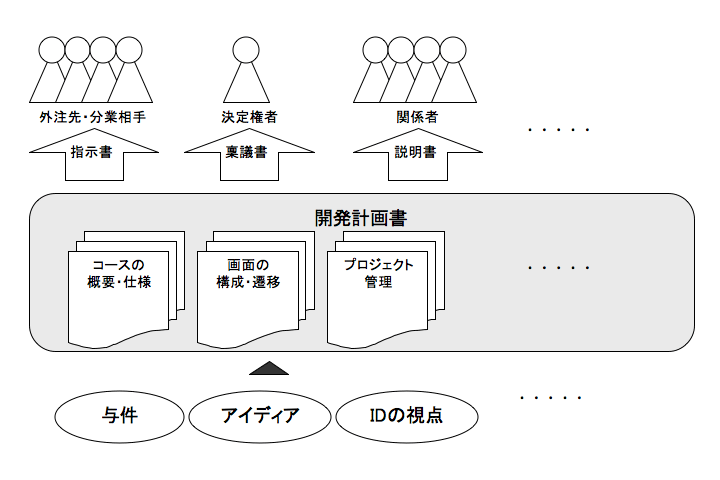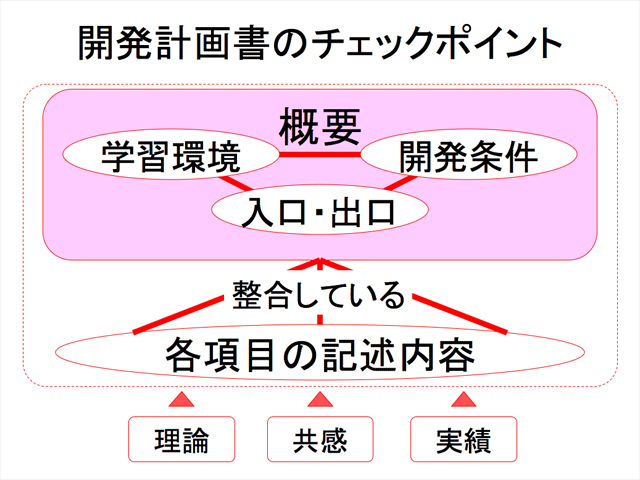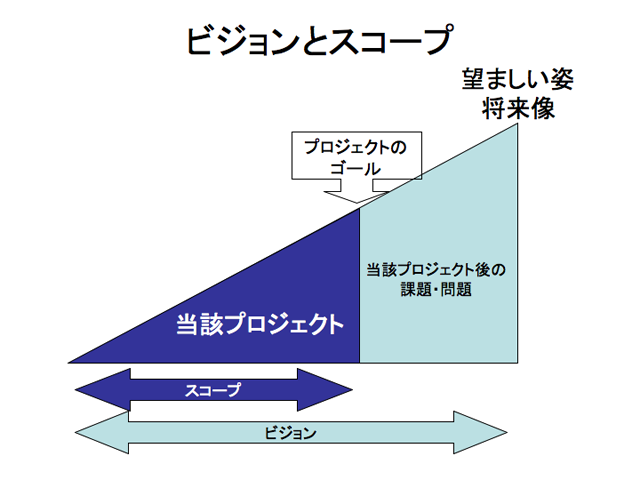Text 1: What is a development plan?
XYZ of a Development Plan
The goal of the three blocks is to create a "development plan". So what is a "development plan"? Let's think about it for a moment.
First, as a warm-up, try to describe the "development plan" you are about to write in your own way using the XYZ formula you learned in this course. You don't have to choose only one answer. Write down as many as you can think of.
Z (for what?) :
Y (how = by describing or writing what?) :
X (what does it do = for what purpose?) :
Next, let's do a logic check.
Doing Y can do X.
Doing X can be positive/contribute to Z.
Instructor's experience: "Don't we need a development plan?"
The lecturer (Kitamura) has been involved in e-learning related work since he was working for a company. His specific work included e-learning research, proposals, implementation, deployment, development, sales, and marketing...in other words, he did almost everything by himself. At that time, I did not need to write any plans, although I did write approval documents for implementation and development. This was because I was practically in charge of the project, and I even did the actual work, so as long as I got my boss's OK, or to put it more simply, as long as the budget was approved, I could do the rest by myself. As long as I had a plan in my head (even if it wasn't clear ・・・・), I could just do my best to meet the deadline and do it flexibly and flexibly (it sounds good to say, but in essence, it was "haphazard"). In the beginning, we could only do small-scale projects as trials. At that point, we did not need a "development plan".
However, as the development of e-learning progressed and the scale of development became larger, it became impossible for me to handle it by myself. First of all, we had to secure personnel, and in some cases, outsource the work. To do this, we had to ask our superiors for approval of what kind of work would be done and at what timing, and we also had to present the plan to the entire department for coordination.
We also needed to explain the concept, specifications, and work flow of the project to the personnel and subcontractors that we had secured, and instruct them on which tasks to be done and by when, and manage the progress. In order to do this, it became essential to organize and visualize the given conditions and circumstances, and the desires and ideas of "this is what I want" that used to be in my head./p>
In this way, the development plan, which was not necessary while I was working alone, became indispensable as soon as the e-learning work started running smoothly.
Uses and Elements of a Development Plan
Now, with all this in mind, let's think about what a development plan is.
The "for what" is, of course, to ensure the success of the development and implementation. (What constitutes success needs to be defined for each project...)
What to do can be thought of in various ways, but I think it can be roughly organized into the following two categories.
The first is to organize and examine "what you want to do" and "what you should do. The first is to organize and examine "what we want to do" and "what we should do". This includes clarifying the "given conditions" and organizing ideas.
The second step is to communicate "what we want to do" and "what we should do" to the people concerned and proceed with the study and development. This includes obtaining development permission, budget, and personnel from decision makers, presenting the image of the product to be developed to related parties, and proceeding with the project (division of labor and collaboration).
In other words, the content and components that should be shown may include the following.
- What is the general nature of the project and what is the goal?→Overview
- What are the constraints?→Specifications
- What kind of product is it?→Screen structure and transition diagram
- How to proceed→Project management (process, schedule, WBS)
Of course, there may be other items as well.

The outline tends to be an "afterthought," but the instructor believes that it is actually very important. This is because stakeholders and learners learn about the course from the outline, and the outline is often the only thing that is conveyed. In fact, if there is an outline at the beginning of various documents, it is not uncommon for people to read only that.
The outline can also be used as the "center of your own thinking. If you have your own concept written in the outline, you can make sense of your planning and project by checking whether the outline (concept) is consistent with various items. On the other hand, as you examine the items, you will have the opportunity to notice that the outline (concept) needs to be corrected or revised, that is, that there are fundamental problems, such as inconsistencies with the given development conditions, learning environment, or the defined exits and entrances.
In addition, in order to increase the persuasiveness of the document as a request for approval or a proposal, it is good to provide theoretical support, desirability that will gain the sympathy of the person with whom you are proposing or collaborating, and a track record that shows feasibility.

Other points to keep in mind
Keep the following points in mind when writing development plans and proposals.
◎◎Outcome objectives (outputs) and evaluation of the project
A project expert once said, "If there are 100 projects, 10 will be successful and 10 will be unsuccessful. The other 80 don't even know if they succeeded or failed. This is because the criteria and goals of the project are unclear, and that is the biggest problem.
In order to prevent this from happening, it is important to state what exactly will be the outcome of the project (what will be considered a success) and how it will be evaluated. This will enable you to share the direction of the project more clearly with the proposer, and to obtain a fair evaluation of the project from the proposer at the end of the project. Also, in the event of a "failure," you will be able to learn lessons for the next time.
◎Present multiple solutions
In order to show the merits of your "best" solution, you should present multiple solutions. "By comparing the advantages and disadvantages of each solution, you can support the customer's decision-making process and make the "best" solution more appealing.
◎Risks associated with the proposal
Describe the risks associated with the proposal, such as shortage of personnel and budget, late delivery, and a large number of students who do not complete the course as scheduled. Describe measures to prevent or mitigate these risks, as well as measures to deal with them if they do occur. This will make it easier for the reader to judge the feasibility of your proposal.
◎Use theory as your ally
In order to prove the appropriateness of your proposal or plan, or in other words, to "justify" (never "complicate") it, you need to show why it is appropriate. One of our strongest allies is theory. If you can say something like, "This proposal has a theoretical background," you can easily and strongly "justify" it.
This is the theory of ID that you are studying. By all means, use them in your proposals as well.
◎Future vision (vision) and proposal scope (scope)
Describe the vision of where you want to go in the future with this proposal, the scope of the proposal, and the issues that need to be addressed after the proposal in order to realize the vision. The vision can be said to be "a situation that satisfies the true needs and wants of the customer side" beyond this proposal.
This will help you promote the value of this proposal more strongly.

While considering the above points, let's create our own development plan. Of course, you may use the format and items that you use in your daily work. I am looking forward to seeing your unique plans.